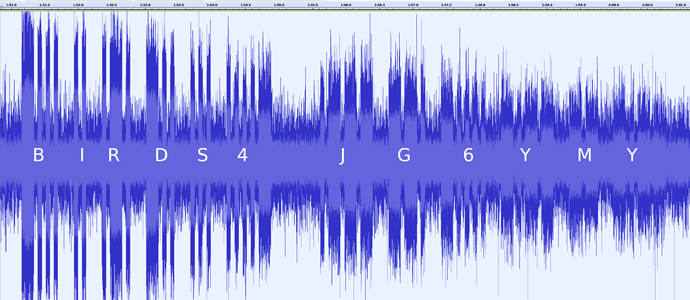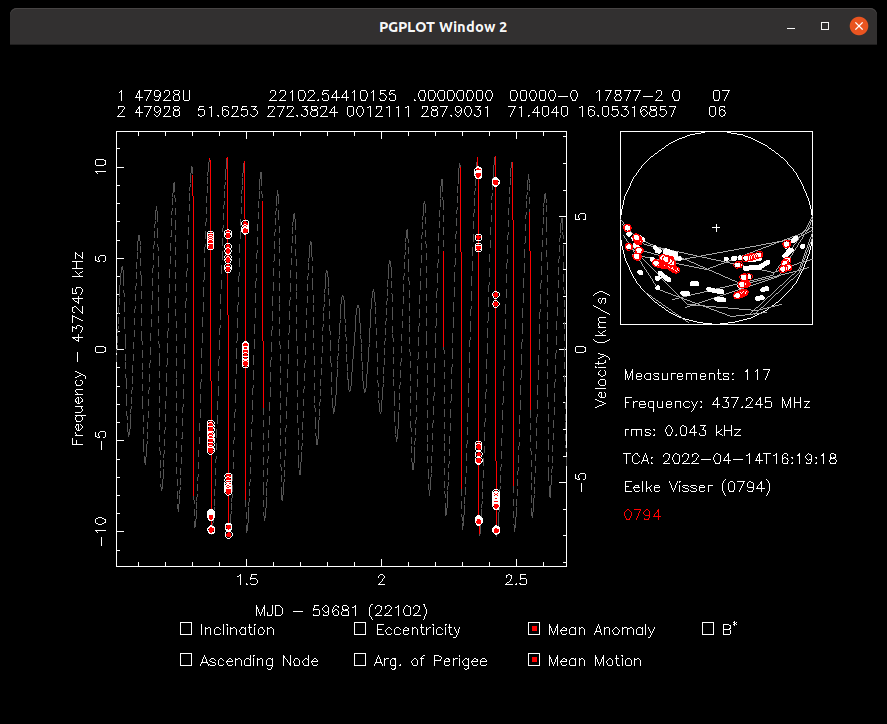@fredy you were right. OBJECT SH(47931) and OBJECT SG(47930) are great guesses for OPUSAT-2. But we found out that yesterday during MEL83deg pass, doppler shift correction was not 100% accurate by using OBJECT SH(47931). We have changed to use OBJECT SG(47930) as OPUSAT-2 for now.
@eon Cool! I’ve changed it to OBJECT SG(47930), but still it is too close with the other objects to identify it. Hopefully the next days we will have a separation enough for identification. Could you inform us about the status of the satellite, if anything looks good? Also any hint why it didn’t started transmitting after the deployment but some days later?
@fredy OPUSAT-2 is doing great as in battery voltage, 0 abnormity counter after deployment from ISS, getting great signal even during low MEL degree pass.
That is one of the misterious. We assumed that is due to the antenna of satellite failed to deploy by using nichrome wire. As we have set it automatically execute the antenna deployment every 24hours if did not received any signal from ground station. After 8th attempts only successful deploy by it self, and finally got the first signal on 21th March (UTC11:27).
@fredy Hi, we are highly believed OBJECT SG(47930) is OPUSAT-2. We had tried both OBJECT SH and OBJECT SF 's TLE and found out both of it doppler shift correction were not accurate.
My method is using ikhnos which is not as accurate as other methods like using strf tools. With my method SG seems to be the best fit, but the rest are still too close for letting me say that 100% is SG.
If your calculations and methods are more accurate than ikhnos ones, please provide the data that shows the fit, so we can identify it and change its NORAD ID in both DB and Network.
OPUSAT-II is now identified as OBJECT SG( 47930), here are the results of ikhnos on observation 3879619.
@eon given that OPUSAT-II signal is strong, do you know if it is expected to start transmit on other modes than CW?
Remaining satellites for identification are two of the Birds4, MAYA-2 and GUARANISAT-1, and WARP-01.
WARP-01 hasn’t been received until now, while the two of the Birds4 haven’t been received for more than 15 days(https://network.satnogs.org/observations/3792250/ and https://network.satnogs.org/observations/3781678/).
From the deployment times and the receptions we continue to follow OBJECT SA(47924) for WARP-01, OBJECT SF(47929) for MAYA-2 and OBJECT SH(47931) for GUARANISAT-1.
MAYA-2 was received in 3 observations of TSURU at around 2021-04-04 12:50 UTC and around 2021-04-04 13:21:48 UTC:
3894646 by 1667 - AAS Berga Carballada
3894332 by 753 - UY0LL
3894298 by 692 - VK4XSS-70
Here are the results of ikhnos for the 2 of the 3 observations which prove identification of MAYA-2 as OBJECT SF(47929) and bellow is the image showing the CW in the waveform of observation 3894332 that confirms the callsign of MAYA-2:
Unfortunately we didn’t have any other reception after these ones.
The only unidentified satellites from this launch is WARP-01 and GURANISAT-1. That latter has been received in the past, so we expect to receive it again, as happened with MAYA-1. WARP-01 hasn’t been received yet from SatNOGS Network, however there are reports in twitter, like the one bellow, that report reception of WARP-01:
After @PE0SAT said that he has seen something in strf which looks like WARP-01, I’ve checked and we have received multiple times WARP-01 the last hours.
With this we can identify WARP-01 as OBJECT SA(47924) and the remaining GUARANISAT-1 as OBJECT SH(47931).
Here are the results of ikhnos on observation 3890651 for WARP-01.
So bellow is the summary for this deployment:
-
TAUSAT-1: identified as OBJECT SC(47926)
- Here are the results of ikhnos on observation 3816232.
-
OPUSAT-II: identified as OBJECT SG(47930)
- Here are the results of ikhnos on observation 3879619.
-
TSURU: identified as OBJECT SD(47927)
- Here are the results of ikhnos on observation 3816489.
- MAYA-2: identified as OBJECT SF(47929)
-
GUARANISAT-1: identified as OBJECT SH(47931)
- Identification by having identified all other satellites from this deployment
-
RSP-01: identified as OBJECT SB(47925)
- Here are the results of ikhnos on observation 3816752.
-
WARP-01: identified as OBJECT SA(47924)
- Here are the results of ikhnos on observation 3890651.
-
STARS-EC: identified as OBJECT SE(47928)
- Here are the results of ikhnos on observation 3816283 .
Hi,
I am a student of Osaka Prefecture Univ. and a member of the OPUSAT-II (HIROGARI) operation team .
First of all, I’d like to say thank you for everyone here for identifying CubeSats including our OPUSAT-II.
Informations here were so helpful for us to identify and find our satellite.
Today, I’m sending this message to inform about message box service of our satellite.
Message box service is for amateur radio operators. Amateur radio operators can uplink messages to OPUSAT-II, and can downlink them by FM downlink. Therefore, Amateur radio operators ALL OVER THE WORLD can share massages through OPUSAT-II.
OPUSAT-II (HIROGARI) mission description
We will conduct test operation of the message box on the following schedule.
June 18, 9:47pm - June 19, 4:18am
June 19, 10:34pm-June 20, 3:28am
(UTC)
The informations needed to join this service (such as command format and generator, uplink/downlink mode and frequency, decode software) are available on the following link.
https://www.sssrc.aero.osakafu-u.ac.jp/hrg_amateur_mission/#/
I remember that @fredy was wondering whether OPUSAT-II transmit on other modes than CW.
Answering this, OPUSAT-II transmits FM only when command uplinked, which means OPUSAT-II usually transmits FM only over Japan(because we uplink mission command from Japan).
But during conducting message box service, it transmits FM on other areas if amateur radio operators join the service and uplink message box commands. (Uplink command which is not from us is acceptable only when conducting message box service)
I would like lots of amateur radio operator all over the world to join.
If you have any question, please reply.
Thanks.
Thanks @forestwaterfall for the detailed message!
I’m going to schedule some observations with random downlink modes as it depends on what the uplink message will select. However if anyone is going to try a specific mode let us know here so we can schedule to receive that specific downlink mode.
EDIT: observations have been scheduled for both days.
https://network.satnogs.org/observations/4284218/
Opusat-II was transmitting CW, but was received in FM mode. The strange thing is, that at 3:21 a local repeater was heard. DB0HHH transmitts on 145.750 MHz and is located 40 km away from my location.
I just checked the repeater transmission with my dx antenna (M2, 2M5WL), the signal is clean.
STARS-EC is near its re-entry, so here is a TLE set generated by @cgbsat based on doppler:
STARS-EC
1 47928U 22099.62500000 .00000000 00000-0 17282-2 0 00
2 47928 51.6294 287.7297 0007157 247.1227 189.5206 15.98329965 04
STARS-EC starts to deviate from its TLE. The TLE is 2 days old now, and I don’t know when to expect a new one. Anyway, I have fitted MA and MM to get a new one. I also tried B*, but that did not change. Propagated TLE:
STARS-EC
1 47928U 22104.49996528 .00000000 00000-0 17877-2 0 06
2 47928 51.6253 261.8192 0012111 263.0413 267.6367 16.11487984000004
# 20220413.37-20220414.43, 117 measurements, 0.043 kHz rms
Edit: Fixed checksum

